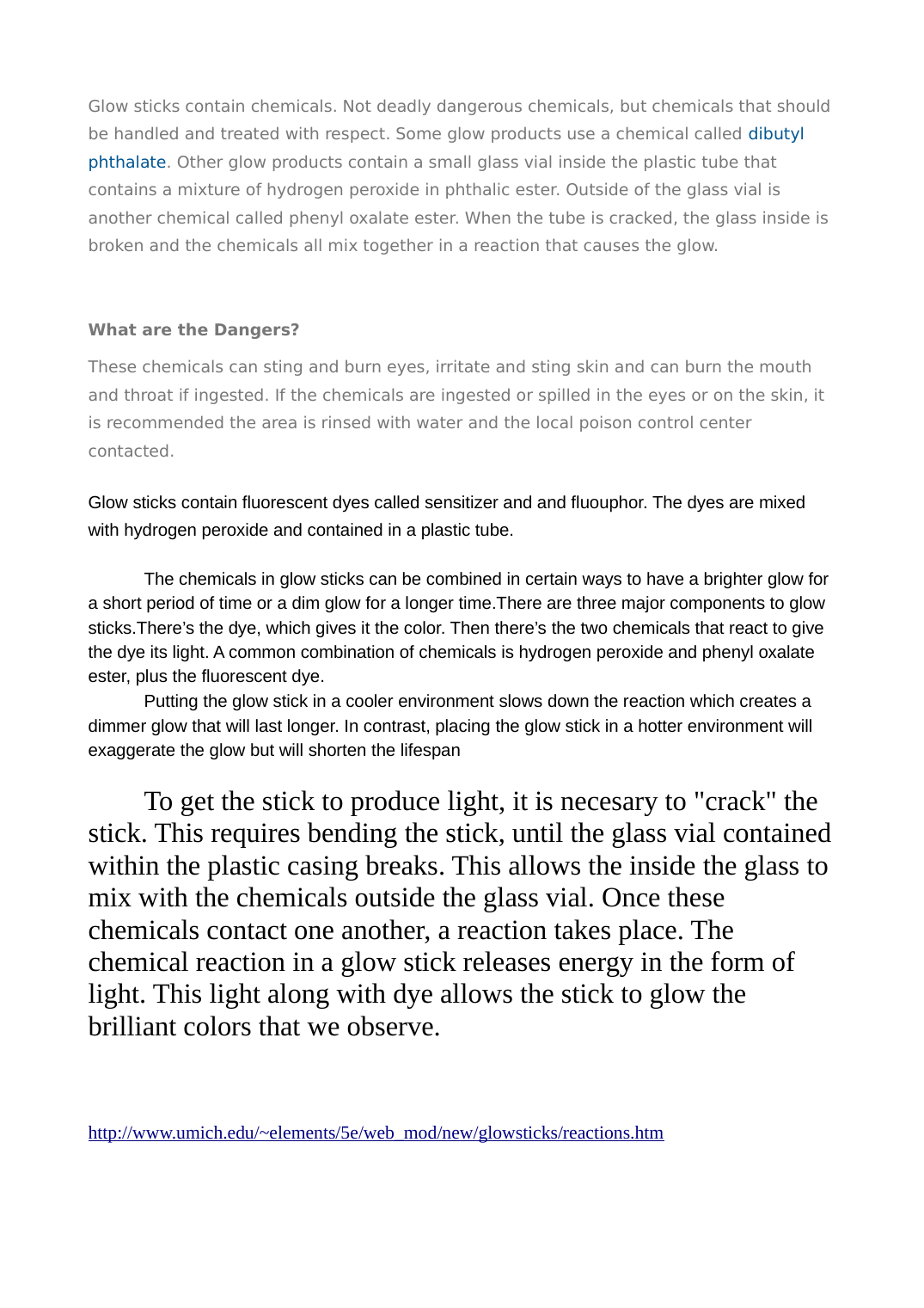baton lumineux
Publié le 23/05/2020

Extrait du document
«
Glow sticks contain chemicals.
Not deadly dangerous chemicals, but chemicals that should
be handled and treated with respect.
Some glow products use a chemical called dibutyl
phthalate .
Other glow products contain a small glass vial inside the plastic tube that
contains a mixture of hydrogen peroxide in phthalic ester.
Outside of the glass vial is
another chemical called phenyl oxalate ester.
When the tube is cracked, the glass inside is
broken and the chemicals all mix together in a reaction that causes the glow.
What are the Dangers?
These chemicals can sting and burn eyes, irritate and sting skin and can burn the mouth
and throat if ingested.
If the chemicals are ingested or spilled in the eyes or on the skin, it
is recommended the area is rinsed with water and the local poison control center
contacted.
Glow sticks contain fluorescent dyes called sensitizer and and fluouphor.
The dyes are mixed
with hydrogen peroxide and contained in a plastic tube.
The chemicals in glow sticks can be combined in certain ways to have a brighter glow for
a short period of time or a dim glow for a longer time.There are three major components to glow
sticks.There’s the dye, which gives it the color.
Then there’s the two chemicals that react to give
the dye its light.
A common combination of chemicals is hydrogen peroxide and phenyl oxalate
ester, plus the fluorescent dye.
Putting the glow stick in a cooler environment slows down the reaction which creates a
dimmer glow that will last longer.
In contrast, placing the glow stick in a hotter environment will
exaggerate the glow but will shorten the lifespan
To get the stick to produce light, it is necesary to "crack" the
stick.
This requires bending the stick, until the glass vial contained
within the plastic casing breaks.
This allows the inside the glass to
mix with the chemicals outside the glass vial.
Once these
chemicals contact one another, a reaction takes place.
The
chemical reaction in a glow stick releases energy in the form of
light.
This light along with dye allows the stick to glow the
brilliant colors that we observe.
http://www.umich.edu/~elements/5e/web_mod/new/glowsticks/reactions.htm.
»
↓↓↓ APERÇU DU DOCUMENT ↓↓↓
Liens utiles
- L'amour n'est qu'un point lumineux, et néanmoins il semble s'emparer du temps. Il y a peu de jours qu'il n'existait pas, bientôt il n'existera plus; mais tant qu'il existe, il répand sa clarté sur l'époque qui l'a précédé, comme sur celle qui doit suivre. Dans quelle mesure cette citation empruntée au roman Adolphe de Benjamin Constant s'applique-t-elle à Roméo et Juliette en tant que tragédie devenue mythe de l'amour ?
- Avec son visage sans rides, ses jeans délavés et sa montre au cadran lumineux, il n'a pas l'air d'un sorcier. Andrée Poulin, la Disparition du bébé chocolat, Québec Amérique
- Le visage soudain plus lumineux, elle se mit à murmurer à l'oreille de sa mère et réussit à la convaincre de revenir parmi les vivants. Maryse Rouy, les Jardins d'Auralie, Québec Amérique
- Tandis que, les deux cornes en avant, un limaçon qu'avait égaré la nuit cherchait sa route sur mes vitraux lumineux. Aloysius Bertrand, Gaspard de la nuit, ABU, la Bibliothèque universelle
- Baton Rouge.


